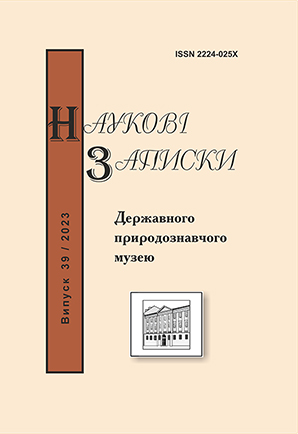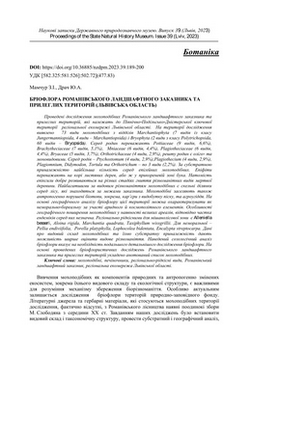Mamchur Z.I., Drach Y.A.
Bryoflora of the Romaniv landscape region and adjacent territories (Lviv region) // Proc. of the State Nat. Hist. Mus. - Lviv, 2023. - 39. - P. 189-200 DOI: https://doi.org/10.36885/nzdpm.2023.39.189-200 Key words: mosses, liverworts, regionally rare species, Romaniv landscape reserve, regional eco-network of Lviv region Research was conducted on bryophytes of the Romaniv landscape reserve and adjacent territories, which belong to the North-Podilskyi-Dniester key territory of the regional eco-network of the Lviv region. 73 species of bryophytes from the divisions Marchantiophyta (7 species from the class Jungermanniopsida, 4 species – Marchantiopsida) and Bryophyta (2 species from the class Polytrichopsida, 60 species – Bryopsida) were found in the study area. Among the families, Pottiaceae (9 species, 6.6%), Brachytheciaceae (7 species, 5.1%), Mniaceae (6 species, 4.4%), Plagiotheciaceae (6 species, 4.4%), Bryaceae (5 species, 3.7%), Orthotrichaceae (4 species, 2.9%), the rest of the families are oligo- and monospecies. Among the genera are Ptychostomum (4 species, 2.9%), Plagiothecium (4 species, 2.9%), genera Plagiomnium, Didymodon, Tortula and Orthotrichum – 3 species each (2.2%). According to the substrate affiliation, there is the largest number of epigean bryophytes. Epiphytes predominate on the bark of deciduous trees, or in the root zone of beech trees. However, epixillae develop well at various stages of decay in various types of dead wood. Rocky areas in the middle of the forest, which are located outside the reserve have the biggest species diversity of bryophytes Mosses inhabit anthropogenically disturbed biotopes, in particular, sand mining quarries and agricultural land. Based on the geographical analysis, the bryoflora of this territory can be characterized as nemoral-boreal with some arid and cosmopolitan elements. Features of the geographical distribution of bryophytes are large areas, accordingly, the share of endemics among them is insignificant. Regionally rare for the mixed forest zone are Alleniella besseri, Aloina rigida, Marchantia quadrata, Taxiphyllum wissgrillii. For nemoral – Pellia endiviifolia, Porella platyphylla, Lophocolea bidentata, Encalypta streptocarpa. Data on the species composition of bryophytes and their substrate affiliation make it possible to more widely assess the types of biodiversity. The given sozological analysis of the bryoflora points to the need for further detailed research of the bryoflora. An annotated list of bryophytes was drawn up on the basis of bryofloristic studies of the Romaniv landscape reserve and adjacent territories.
Bryoflora of the Romaniv landscape region and adjacent territories (Lviv region) // Proc. of the State Nat. Hist. Mus. - Lviv, 2023. - 39. - P. 189-200 DOI: https://doi.org/10.36885/nzdpm.2023.39.189-200 Key words: mosses, liverworts, regionally rare species, Romaniv landscape reserve, regional eco-network of Lviv region Research was conducted on bryophytes of the Romaniv landscape reserve and adjacent territories, which belong to the North-Podilskyi-Dniester key territory of the regional eco-network of the Lviv region. 73 species of bryophytes from the divisions Marchantiophyta (7 species from the class Jungermanniopsida, 4 species – Marchantiopsida) and Bryophyta (2 species from the class Polytrichopsida, 60 species – Bryopsida) were found in the study area. Among the families, Pottiaceae (9 species, 6.6%), Brachytheciaceae (7 species, 5.1%), Mniaceae (6 species, 4.4%), Plagiotheciaceae (6 species, 4.4%), Bryaceae (5 species, 3.7%), Orthotrichaceae (4 species, 2.9%), the rest of the families are oligo- and monospecies. Among the genera are Ptychostomum (4 species, 2.9%), Plagiothecium (4 species, 2.9%), genera Plagiomnium, Didymodon, Tortula and Orthotrichum – 3 species each (2.2%). According to the substrate affiliation, there is the largest number of epigean bryophytes. Epiphytes predominate on the bark of deciduous trees, or in the root zone of beech trees. However, epixillae develop well at various stages of decay in various types of dead wood. Rocky areas in the middle of the forest, which are located outside the reserve have the biggest species diversity of bryophytes Mosses inhabit anthropogenically disturbed biotopes, in particular, sand mining quarries and agricultural land. Based on the geographical analysis, the bryoflora of this territory can be characterized as nemoral-boreal with some arid and cosmopolitan elements. Features of the geographical distribution of bryophytes are large areas, accordingly, the share of endemics among them is insignificant. Regionally rare for the mixed forest zone are Alleniella besseri, Aloina rigida, Marchantia quadrata, Taxiphyllum wissgrillii. For nemoral – Pellia endiviifolia, Porella platyphylla, Lophocolea bidentata, Encalypta streptocarpa. Data on the species composition of bryophytes and their substrate affiliation make it possible to more widely assess the types of biodiversity. The given sozological analysis of the bryoflora points to the need for further detailed research of the bryoflora. An annotated list of bryophytes was drawn up on the basis of bryofloristic studies of the Romaniv landscape reserve and adjacent territories.
References
- Бачурина Г.Ф., Мельничук В.М. 2003. Флора мохів України. Вип. 4. К.: Академперіодика, 255 с.
- Бачурина Г.Ф., Мельничук В.М. 1989. Флора мохів Української РСР. Андреєві, брієві. Вип. 1. К. : Наук. думка, 1987. 180 с.; Вип. 2. 1988. 180 с.; Вип. 3. 176 с.
- Бойко М.Ф. 2010. Раритетні види мохоподібних фізико-географічних рівнинних зон та гірських ландшафтних країн України. Чорноморськ. ботан. журнал. 6, № 3. С. 294–315.
- Геренчук К.І. 1972. Природа Львівської області. Львів: Вид-во Львів. ун-ту, 152 с.
- Зеров Д.К. 1964. Флора печіночних і сфагнових мохів України. Київ : Наук. думка. 356 с.
- Львівська область: природні умови та ресурси: монографія. 2018. За заг. ред. д-ра геогр. наук, проф. М.М. Назарука. Львів : Видавництво Старого Лева, 592 с.
- Регіональна доповідь про стан навколишнього природного середовища у Львівській області в 2021 році. 2021. Доступне https://deplv.gov.ua/regionalna-dopovid-pro-stan-nps/
- Улична К.О. 1976. Бріологічний гербарій. Печіночні мохи. Каталог музейних фондів: зб. наук. праць. К.: Наук. думка, С. 57–73.
- Улична К.О., Вороніна Н.М. 1979. Листяні мохи. III. Каталог музейних фондів: зб. наук. праць. К. : Наук. думка. С. 4–18.
- Улична К.О. 1978. Листяні мохи. I, II. Каталог музейних фондів: зб. наук. праць. К.: Наук. думка. С. 5–92.
- Dierßen K. 2001. Distribution, ecological amplitude and phytosociological charakterization of European bryophytes. Bryophytorum Bibliotheca. Band 56. Berlin – Stuttgard : J. Cramer. 289 p.
- Ellenberg H., Leuschner C. 2010. Zeigerwerte der Panzen Mitteleuropas in: Vegetation Mitteleuropas mit den Alpen: in ökologischer, dynamischer und historischer Sicht. Utb (Pointer values of the plants of Central Europe in: Vegetation of Central Europe with the Alps: in an ecological, dynamic and historical perspective. Utb). 110 p.
- Frego K.A. 2007. Bryophytes as potential indicators of forest integrity. Forest ecology and management. 242 (1). P. 65–75. https://doi.org/10.1016/j.foreco.2007.01.030
- Hill M.O., Preston C.D., Bosanquet S.D.S., Roy D.B. 2007. BRYOATT: Attributes of British and Irish mosses, liverworts, and hornworts – NFRC Centre for Ecology and Hydrology and Countryside Council for Wales, Saxon Print Group, Norwich. 88 p.
- Hodgett, N., Cálix M., Englefield E., Fettes N., García Criado M., Patin L., Nieto A., Bergamini A., Bisang I., Baisheva E., Campisi P., Cogoni A., Hallingbäck T.,Konstantinova N., Lockhart N., Sabovljevic M., Schnyder N., Schröck C., Sérgio C., Sim Sim M., Vrba J., Ferreira C.C., Afonina O., Blockeel T., Blom H., Caspari S., Gabriel R., Garcia C., Garilleti R., González Mancebo J., Goldberg I., Hedenäs L., Holyoak D., Hugonnot V., Huttunen S., Ignatov M., Ignatova E., Infante M., Juutinen R., Kiebacher T., Köckinger H., Kučera J., Lönnell N., Lüth M., Martins A., Maslovsky O., Papp B., Porley R., Rothero G., Söderström L., Ştefǎnuţ S., Syrjänen K., Untereiner A., Váňa J. Ɨ, Vanderpoorten A., Vellak K., Aleffi M., Bates J., Bell N., Brugués M., Cronberg N., Denyer J., Duckett J., During H.J., Enroth J., Fedosov V., Flatberg K.-I., Ganeva A., Gorski P., Gunnarsson U., Hassel K., Hespanhol H., Hill M., Hodd R., Hylander K., Ingerpuu N., Laaka-Lindberg S., Lara F., Mazimpaka V., Mežaka A., Müller F., Orgaz J.D., Patiño J., Pilkington S., Puche F., Ros R.M., Rumsey F., Segarra-Moragues J.G., Seneca A., Stebel A., Virtanen R., Weibull H., Wilbraham J., Żarnowiec, J. 2019. A miniature world in decline European Red List of Mosses, Liverworts and Hornworts. Brussels, Belgium : IUCN. 100 p.
- Hodgetts N.G., Söderström L., Blockeel T.L., Caspari S., Ignatov M.S., Konstantinova N.A., Lockhart N., Papp B., Schröck C., Sim-Sim M., Bell D., Bell N.E., Blom H.H., Bruggeman-Nannenga M.A., Brugués M., Enroth J., Flatberg K.I., Garilleti R., Hedenäs L., Holyoak D.T., Hugonnot V., Kariyawasam I., Köckinger H., Kučera J., Lara F., Porley R.D. 2020. An annotated checklist of bryophytes of Europe, Macaronesia and Cyprus. Journal of Bryology. 42(1). P. 1–116.
- Krupa I. 1885. Zapiski bryologiczne z okolic Lwowa, Krakowa i Wschodnich Karpat. Spraw. Komis. Fizyogr. 19. S. 133–167.
- Mamchur Z., Drach Y., Ragulina M., Prytula S., Antonyak H. 2021. Substrate groups of bryophytes in the territory of the Znesinnya regional landscape park (Lviv, Ukraine). Contributii Botanice. (56). P. 65-77. DOI: 10.24193/Contrib.Bot.56.7
- Mamchur Z., Drach Yu., Antonyak H. 2020. Ecological features and synanthropization of bryoflora in the Pohulyanka forest park (Lviv city, Ukraine). Contribuţii Botanice. (55). LV: P. 83–95. DOI: 10.24193/Contrib.Bot.55.5
- Pykälä J. 2019. Habitat loss and deterioration explain the disappearance of populations of threatened vascular plants, bryophytes and lichens in a hemiboreal landscape. Global Ecology and Conservation. 18, e00610. DOI: https://doi.org/10.1016/j.gecco.2019.e00610


